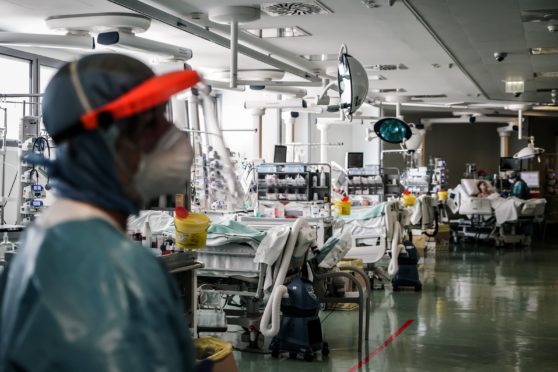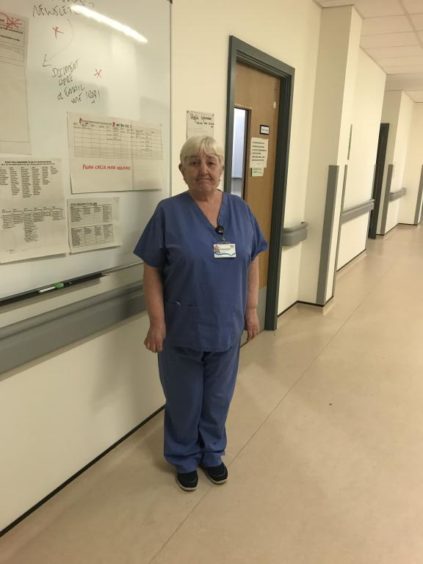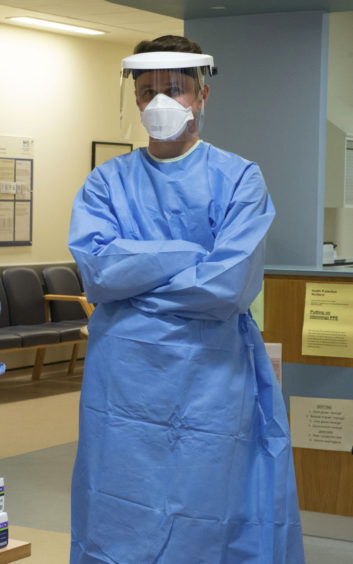
One of the network of critical care units providing intensive treatment to the most seriously ill coronavirus patients is the ICU at Glasgow’s Queen Elizabeth University Hospital – the largest ICU in Scotland.
It has now been increased to 40 intensive care beds, and 39 high dependency beds.
Here The Sunday Post speaks to two colleagues at the ICU, lead consultant Andy Mackay and domestic assistant Margaret Murray, who describe life on the ward in a time of unprecedented crisis.
“I have never been so busy and I have never, ever been so proud. I just want to help”
 Margaret Murray, 63, of Glasgow, has worked as a domestic assistant in the Intensive Care Unit for the past 12 years.
Margaret Murray, 63, of Glasgow, has worked as a domestic assistant in the Intensive Care Unit for the past 12 years.
I can never remember work being as busy as this. Everyone is working extremely hard in an understandably tense atmosphere with critically ill patients.
Like everyone who works in Intensive Care I have to wear high-level personal protection equipment which takes 10 minutes to don and doff.
That’s one pair of gloves, gown, another set of gloves, mask and then face shield.
It’s heavy, hot work but it has to be done.
I work a seven-and-a-half hour shift, and shower and wash my hair before leaving work. Working with Covid, everything is double-bagged to prevent infection.
You get so used to distancing that even when I get home I sit at one end of the table and my husband David, is at the other. We also watch TV from opposite ends of the couch.
Like everyone else, I worry about taking Covid home. Fortunately I haven’t had it. I am isolated from my grandchildren but see them through the window when they pass the house, on a walk.
It’s how it has to be. I was worried at first but I have the total support of my employers. They have my back.
I don’t see myself as anything special. I’m just happy and proud to be helping the patients and colleagues in ICU.
When I see how hard they work, they are my heroes.
“These are some of the longest, hardest shifts of my 17 years in intensive care. It’s a constant battle and the unit feels more like a military operation”
 Doctor Andy Mackay is back at work after a mild form of Covid-19. He believes he picked it up in the community, prior to social distancing, rather than on the ward and went back to work two weeks ago.
Doctor Andy Mackay is back at work after a mild form of Covid-19. He believes he picked it up in the community, prior to social distancing, rather than on the ward and went back to work two weeks ago.
Many of us work a 13-hour day and the demands of Covid-19 mean ICU and High Dependency have to be run like a military operation.
We have eight consultants on duty at any one time from a group of 48 in total, working alongside junior doctors and nurses in teams with responsibility for 10-20 seriously ill patients.
All of us are completely dependent on our back-up team of nurses, physiotherapists, pharmacists, dieticians, technicians and cleaners, all working to keep patients alive.
My day begins with a handover from the staff going off-shift and an update on activity level on the floor.
Throughout the day the phone goes constantly with referrals of new seriously-ill patients heading to ICU from A&E or a medical ward.
I then do a ward round, assess all my patients and see if their drugs need changing, if they need extra lab tests or CT scans. Their breathing tubes may also need changing or adjusting.
I then speak to their families to update them on their loved ones’ progress.
If we can do no more for the patient then we consider whether one member of the family can be with them. It’s a balancing act as it increases the risk of exposing that family member to Covid-19 by having them in ICU. If they wish, they only enter the unit once gowned and gloved with a face mask.
Sicker patients shed a higher level of Covid-19 load because the virus affects the lungs so the risk is not inconsiderable.
It’s a constant battle of trying to do the right thing.
The shifts are long and hard, especially because of the PPE, and it would be fair to describe them as some of the hardest I’ve had in 17 years in intensive care.
The atmosphere is calm. Despite the severity of the disease and the challenges it brings, we work in a highly functioning team that is used to looking after extremely sick people.
Most Covid-19 patients are 50 and older. A lot of the patients are overweight with high blood pressure and diabetes. It’s not like treating patients with the flu – the patients have markedly poorer lung and heart function.
After a run of three to four 13-hour days or nights, we head home for a few days to recover.
None of it would be possible without the incredible team work and commitment of colleagues all looking out for each other.

Enjoy the convenience of having The Sunday Post delivered as a digital ePaper straight to your smartphone, tablet or computer.
Subscribe for only £5.49 a month and enjoy all the benefits of the printed paper as a digital replica.
Subscribe